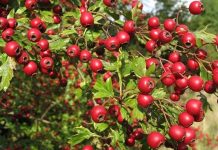Nature’s Guardian for the Heart: The Medicinal Secrets of Hawthorn

For centuries, hawthorn — a small tree adorned with white blossoms and bright red berries — has been revered as one of nature’s greatest gifts for the heart. Known scientifically as Crataegus, this plant has deep roots in both folk tradition and modern herbal medicine. From ancient healers to contemporary scientists, hawthorn has earned a reputation as the gentle guardian of cardiovascular health, a natural ally for circulation, strength, and emotional balance.
A Plant with a Sacred Past
Hawthorn’s story begins in the forests and meadows of Europe and Western Asia, where it has grown wild for thousands of years. In Celtic folklore, the hawthorn tree was considered sacred — a symbol of love, protection, and renewal. People believed that spirits lived within its branches, and cutting down a hawthorn was said to bring misfortune. But alongside its mystical symbolism, it also held a deeply practical role: healers used its leaves, flowers, and berries as powerful medicine for the heart and blood.
In Georgian and Slavic folk medicine, hawthorn was often brewed into tea or tincture to calm palpitations, lower blood pressure, and “strengthen the heart.” Elders would recommend drinking hawthorn tea after physical work or emotional stress, calling it “the heart’s rest.” These traditional uses closely align with what science later confirmed — hawthorn indeed improves circulation and supports cardiovascular function.
Folk Remedies and Traditional Uses
For generations, hawthorn has been part of everyday healing practices. Rural healers used different parts of the plant throughout the seasons: the blossoms in spring, the green leaves in summer, and the red berries in autumn. Each had its purpose, and together they created a full circle of heart support.
Common folk recipes included:
Hawthorn berry tea: Made by simmering dried berries in water to soothe heart rhythm irregularities and anxiety.
Hawthorn flower infusion: Used to improve blood circulation and reduce dizziness caused by low blood pressure.
Hawthorn tincture: Alcohol-based extract taken in small drops to strengthen the heart muscle and ease tension.
Honey and hawthorn syrup: A traditional Georgian and Balkan remedy to “calm the heart and clear the blood.”
These preparations were not only physical treatments but emotional ones as well. Folk healers believed that the heart was the seat of both emotion and vitality — and hawthorn, with its thorny branches and sweet berries, symbolized resilience and compassion combined.
What Modern Science Reveals
Modern research has given hawthorn’s legendary reputation scientific credibility. Studies show that hawthorn is rich in flavonoids and oligomeric procyanidins — powerful antioxidants that improve blood vessel elasticity, enhance oxygen flow to the heart, and lower cholesterol levels.
Clinical trials have also demonstrated that hawthorn extracts can:
Dilate coronary arteries, improving blood supply to the heart.
Strengthen the heartbeat without increasing oxygen demand.
Lower blood pressure gently, without side effects associated with synthetic drugs.
Reduce anxiety and improve sleep, thanks to mild sedative compounds.
Because of these effects, hawthorn is now recognized in European herbal pharmacopoeias as a natural aid for mild heart failure, hypertension, and anxiety-related palpitations. It is often prescribed alongside other treatments, especially for older adults seeking natural cardiovascular support.
The Heart’s Emotional Connection
In folk tradition, the heart is not only a physical organ but also the center of emotion, courage, and love. Healers once said that hawthorn could “open the heart” — not just to improve blood flow, but to release emotional blockages such as grief or fear.
Modern herbalists echo this sentiment. Hawthorn is often used in holistic medicine to support people recovering from emotional trauma or heartbreak. Its gentle, grounding energy is said to restore emotional equilibrium — a poetic yet meaningful reminder that body and soul are deeply intertwined.
How to Use Hawthorn Today
Today, hawthorn is available in many forms — teas, capsules, tinctures, and extracts. For those who prefer traditional preparations, hawthorn tea remains one of the simplest and most soothing options.
To make hawthorn tea:
Add one tablespoon of dried hawthorn berries or flowers to a cup of boiling water.
Let it steep for 10–15 minutes.
Drink one or two cups a day, preferably after meals or before bedtime.
For a tincture, 20–30 drops diluted in water, taken twice a day, is often recommended by herbalists. However, it’s always important to consult a healthcare professional, especially if you are already taking prescription heart medications, as hawthorn may enhance their effects.
Cautions and Considerations
While hawthorn is remarkably safe for most people, it must be used with awareness. Overconsumption can cause mild dizziness or low blood pressure. Because hawthorn can interact with certain heart medications (like beta blockers or digitalis), it’s best to consult a doctor before combining them.
Pregnant or breastfeeding women should also use hawthorn cautiously, as its effects in these cases are not fully studied.
When buying hawthorn supplements or teas, look for high-quality, organic, and standardized extracts to ensure potency. As with any herbal medicine, quality and moderation are key.
A Bridge Between Tradition and Science
Hawthorn stands as a perfect example of how folk wisdom and modern medicine can coexist. What ancient healers discovered through intuition and experience, science now explains through chemistry and physiology. The plant that once grew unnoticed along hedgerows has become a scientifically respected remedy for one of humanity’s most vital organs.
In an age where stress, anxiety, and cardiovascular issues are on the rise, hawthorn offers a gentle, natural way to restore balance. It reminds us that healing often comes not from complex inventions, but from the simple gifts of nature — blooming quietly in the fields, waiting to be rediscovered.
The Guardian of the Heart
From the myths of the Celts to the mountain villages of the Caucasus, hawthorn has always been more than a plant — it is a symbol of endurance, love, and life itself. Its thorns protect, its berries heal, and its blossoms inspire hope.
Even in the modern world, where medicine is driven by technology, hawthorn remains nature’s guardian for the heart — a living bridge between ancient traditions and the timeless rhythm of human life.












